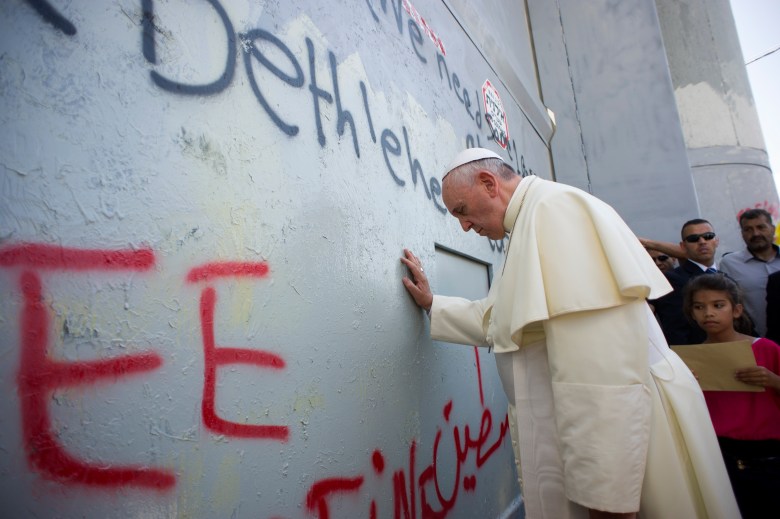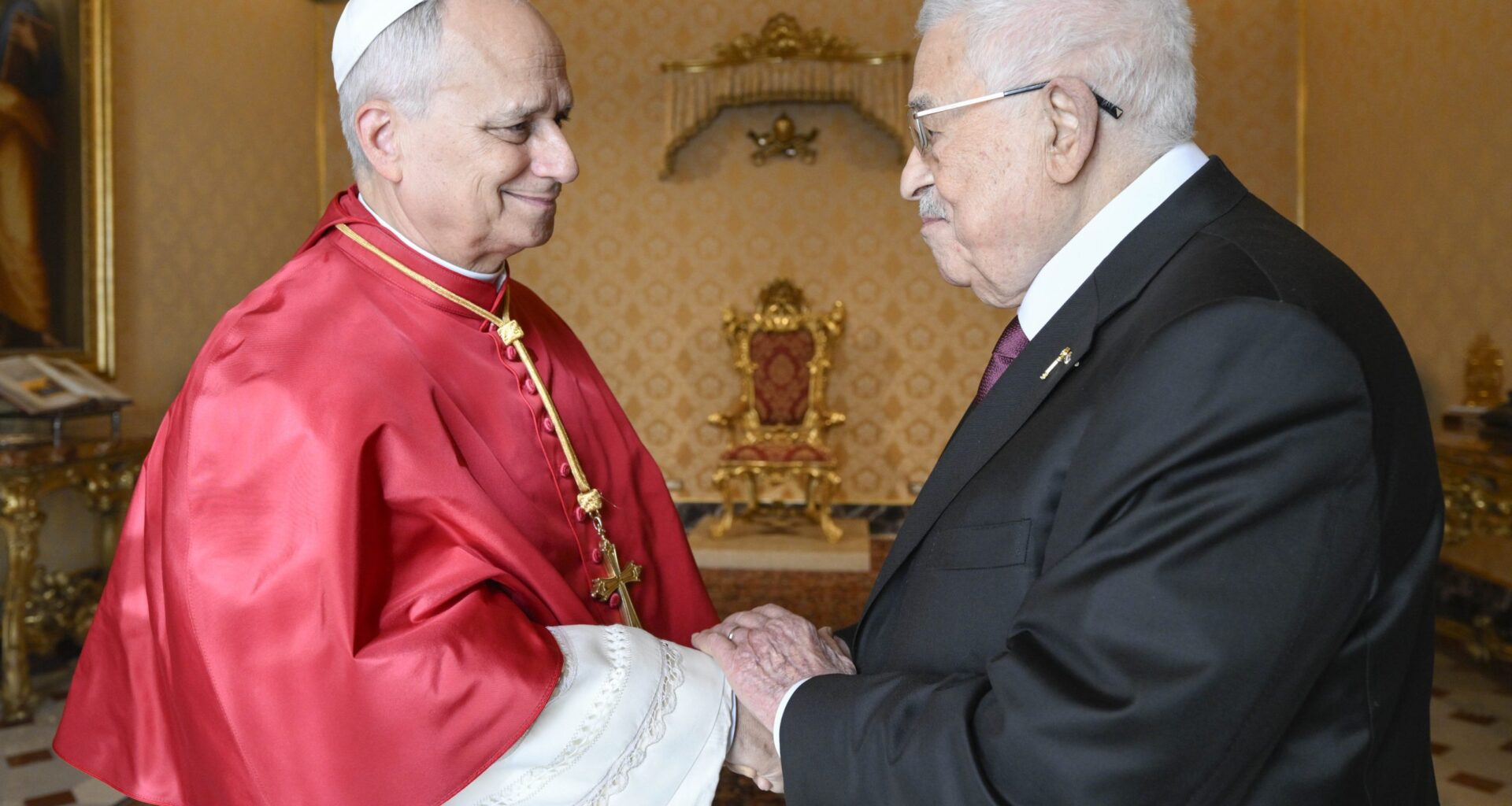Pope Leo XIV and the president of the Palestinian Authority, Mahmoud Abbas, recognized the “urgent need to provide assistance to the civilian population in Gaza and to end the conflict by pursuing a two-state solution,” when they met for the first time in the Vatican this morning, Nov. 5.
The meeting took place almost one month after a fragile cease-fire, brokered by President Trump, came into force following a war that started with Hamas’s terrorist attack on Israel on Oct. 7, 2023. That attack left some 1,200, mostly Israelis, dead and resulted in another 250 being taken into captivity in Gaza. Israel responded with a bombing campaign and military incursion into Gaza that killed over 68,000 Palestinians, including some 18,000 children, and injured more than 170,000, according to the Gaza Ministry of Health. Since the cease-fire took effect, more than 200 have been killed, many of them children, with both sides alleging violations of the deal.
The 2.1 million Palestinians in the enclave, where Israel controls all border crossings, are still grappling with severe shortages of water, food and medicine. The United Nations has called on Israel to open border crossings into the territory, as only a limited amount of the humanitarian aid envisaged by the cease-fire plan has been allowed into Gaza. Israel insists that the bodies of all hostages be returned before more aid can flow in. Under the cease-fire deal, Hamas was to return all of the living and dead hostages within 72 hours, but Hamas says they have struggled to find some bodies amid the rubble. The remains of six hostages have yet to be returned.
The Vatican issued a press communique soon after Mr. Abbas’s visit and said the “cordial meeting” took place in the pope’s private library in the Apostolic Palace. The meeting marked the 10th anniversary of the Vatican’s official recognition of Palestinian statehood through the “Comprehensive Agreement between the Holy See and the State of Palestine (26 June 2015),” the statement said.
That accord regulated and improved the life of the church in Palestine and received substantial international media attention at the time because it was the first time the term “the State of Palestine” was used in a legal agreement between the two sides.
In fact, the Holy See has been referring to “the State of Palestine” since November 2012, when the U.N. General Assembly recognized it as an observer state. The Vatican used the term in its annual yearbooks (Anuario Pontificio) in 2014 and 2015 and on various other occasions. Pope Francis also used the term in his address to President Abbas during his visit to Bethlehem on May 24, 2014.
While the Palestinians were then happy with the ongoing recognition of their statehood by the Holy See and with the comprehensive agreement, the same cannot be said for Israel, according to media reports at that time. The Holy See has been negotiating with the State of Israel for a much longer time—26 years—but has not yet reached a similar comprehensive agreement.
Mr. Abbas is the president of the Palestinian Authority, which exercises limited control over the occupied West Bank. He is also the chairman of the central committee of Fatah, the Palestinian national liberation movement that is a rival of Hamas, which has controlled Gaza since 2007.
 Pope Francis prays for peace in front of the Israeli security wall in Bethlehem, West Bank, May 25. The unscheduled stop was a highlight of the pope’s three-day trip to the Holy Land. (CNS photo/L’Osservatore Romano, pool) See VATICAN LETTER Dec. 12, 2014.
Pope Francis prays for peace in front of the Israeli security wall in Bethlehem, West Bank, May 25. The unscheduled stop was a highlight of the pope’s three-day trip to the Holy Land. (CNS photo/L’Osservatore Romano, pool) See VATICAN LETTER Dec. 12, 2014.Mr. Abbas’s visit to the Vatican today was not his first; he met Leo’s predecessor, Pope Francis, seven times at the Vatican and once in Palestine. They met for the first time in the Vatican in 2013. Their next meeting took place in Bethlehem, when Francis visited the Holy Land in May 2014 and placed his hands on the wall that separates Israel from most of the West Bank. They met a month later in the Vatican, when Mr. Abbas joined Israeli President Shimon Peres and Patriarch Bartholomew of Constantinople in the Vatican gardens for a prayer for peace in the Holy Land on June 5, 2014.
They met again on May 16, 2015, just one month before the formal signing of the Comprehensive Agreement between the Holy See and the State of Palestine. On that occasion, the Argentine pope told the Palestinian leader, “You are a bit of an angel of peace” (In Italian: “Lei é un po’ angelo della pace”), a remark that caused public controversy in some Jewish circles in Israel and the United States.
Mr. Abbas came to the Vatican on that occasion as the head of a high-level Palestinian delegation for the canonization of the first Palestinian saints since the first centuries of the church: Mariam Bawardy (1846-78), the founder of the Carmelite Convent in Bethlehem, and Marie Alphonsine Ghattas (1843-1927), the co-founder of the Congregation of the Sisters of the Holy Rosary, which runs schools to educate poor children.
Mr. Abbas had additional private audiences with Pope Francis in 2017, 2018, 2021 and 2024. It was not surprising, therefore, that soon after arriving in Rome yesterday, President Abbas went to pray and lay flowers at the tomb of Pope Francis in the Basilica of St. Mary Major. “I have come to see him because I cannot forget what he did for the Palestinian people,” he told reporters afterward.
Pope Francis was known for his strong stance on the war in Gaza, appealing for the release of all the hostages, humanitarian relief for Gaza’s 2.3 million inhabitants, an immediate cease-fire and an end to the conflict. He called the parish priest of Holy Family Church in Gaza City more than 450 times, right up to the Saturday before he died. Francis also repeatedly called for a two-state solution as the only sure road to peace in the Holy Land.
Pope Leo, too, has spoken out repeatedly on the situation in Gaza and the Holy Land, including at the Mass for his inauguration on May 18. Like Francis, Leo has called for the release of all hostages, the delivery of humanitarian aid to the suffering Palestinian population in Gaza, an end to the conflict and a two-state solution. He welcomed the cease-fire and has sought to fully support it despite its fragility and uncertainty. Pope Leo has received Israel’s President Herzog and Jordan’s King Abdallah in private audiences, and spoken by phone with Israeli Prime Minister Benjamin Netanyahu.
Related
